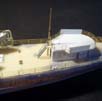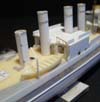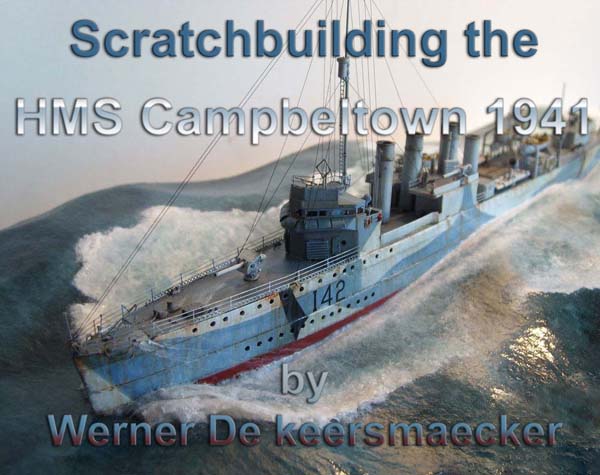| History |
|
HMS Campbeltown was a Wickes Class destroyer, built in the US in 1919.
In 1940 the obsolete ship was handed over to the Royal Navy - which was
in desperate need of convoy escorts as part of a lend-lease program.
Campbeltown had it's first RN refit in 1941. HMS Campbeltown became
famous with operation "Chariot", the St-Nazaire raid, after an extensive
refit in 1942. |
| Scratchbuilding the Hull |
|
| The model, which shows the 1941 refit, is about 90%
scratchbuilt. To make my ship, I used drawings from the Anatomy of the
Ship (AOTS) book. They were scaled down to 1/350 and printed out. |
 |
 |
| The hull sections were glued to a piece of styrene sheet and cut out.
The negatives of these sections were checked to fit against the wooden
hull, which was sawn, carved and sanded to shape. |
 |
| The wooden hull served as a master to make a rubber mould. Resin was
poured in to make a copy of the hull. The resulting part has a lot of air
bubbles that were filled with putty. |
 |
| The plans and sections from the Anatomy of the Ship book, were used
to fabricate the other parts as well. |
 |
| Superstructure and Details |
|
| I used parts of White Ensign Models photo etch sheet for
another 4 stacker (1/350 WEM HMS Burwell), which proved very useful for
boat skids. Unfortunately I got lost one part and had to buy yet another
sheet.
Quite a bit of spare photo etch parts from previous models went into
the details, as well as styrene fittings (rod, strips). |
 |
 |
| The aft deckhouse was built with various parts added from the spare
box. |
 |
| Styrene strips were glued on to create the hull plating. These are
initially overscale so the hull had to be sanded down afterwards. The portholes
were then drilled out. |
 |
| To make the boat skids, styrene parts were glued against
the finished photo etch section to add the correct thickness and form.
another view from the boat skid. the photo etch is very delicate and
nicely detailed but too thin so I decided to add small strips |
 |
 |
| The stern with searchlight platform was done using two sets from
the 1/350 WEM HMS Burwell PE since it had a slightly different platform
construction. |
 |
| The depth charge throwers were made from styrene rod, strips, pre-painted
fishing line, and brass rod. |
 |
| The bridge section was built up with styrene and the interior was detailed.
Unfortunately I have no pictures of the bridge interior details. The funnels
were fabricated from tubing and various brass PE parts. |
 |
| Here the aft deckhouse is dry fitted prior to gluing. |
 |
| The midships section was detailed using the sparse pictures that exist
and a tiny bit of guess work. |
 |
| The boats were modified from other kits' spare parts. |
 |
The boats were carved out and inside detailing was made from scribed
styrene sheet and strips cut to the exact length. Some small hatches and
engine room hatches have been added. |
 |
| The finished 12 pounder gun is shown here prior to painting. |
 |
| The torpedo tubes were made from styrene rods, strips and
some metal and brass rods with spare handwheels added. |
 |
 |
| Here are the 4" ready service racks and Depth Charge throwers ready
for installing. |
 |
| Here are the torpedo directors, steering gear, and searchlight
built up. |
 |
 |
| Finished torpedo directors ready to install. |
 |
| The finished 24" searchlight is shown here with handles
cut out from 1/700 PE ladder stock. |
 |
 |
| The main mast is made from an Aber 1/35 brass antenna and other scratchbuilt
parts. |
 |
| The stern depth charge roller racks are from the WEM HMS Burwell photo
etch set. I added styrene rod cut to length (for depth charges) and
brass rod (for the davits). |
 |
| The finished 4"/50 guns ready to install. The stern gun didn't use
a shield. |
 |
| Sea base |
| The sea base was, like all my previous dioramas, made from
a piece of styrofoam insulation plate. This was cut out using the same
wooden hull master to fit in. The next step was gluing watercolor paper
on the base and cutting it out along the gap. I used the same method of
painting as in my dio "rendezvous north atlantic". Normally I do not paint
the base first but as this is a scratchbuilt model an exception was made.
Just in case I was not satisfied about the sea base and wanted to remove
the model. The last coat was a mixture of acrylic gel, with a tiny bit
of white added to create the water on the deck and coming down. Toilet
paper (soaked in gloss varnish) in several layers was used to give extra
thickness to the foam on the waves. Bow wave was made of toilet paper and
tumble dryer fluff. |
 |
 |
|
|
| Weathering the Model |
|
The finished and painted model was first weathered with the same (Vallejo)
colors as in the western approaches scheme as follows:
-
White was added to the light blue and black areas and a bit of black added
to the white parts.
-
Thinner was added by drawing vertical lines so the darker base colour appears
here and then.
-
Next was "metalising" using a pencil and silver paint, most of it in the
bow area.
-
Then a wash with raw umber (oil paint)
-
Then creating rust with burnt sienna (oil paint),
-
Next was applying a mixture of gloss and satin varnish, corrected with
matte varnish here and there.
|
| References: |
|
Books:
-
Anatomy of the Ship : HMS Campbeltown
-
Squadron : US Flush deckers in action
-
Profile Warship nr. 5
Internet:
and many many others... |
|
|


